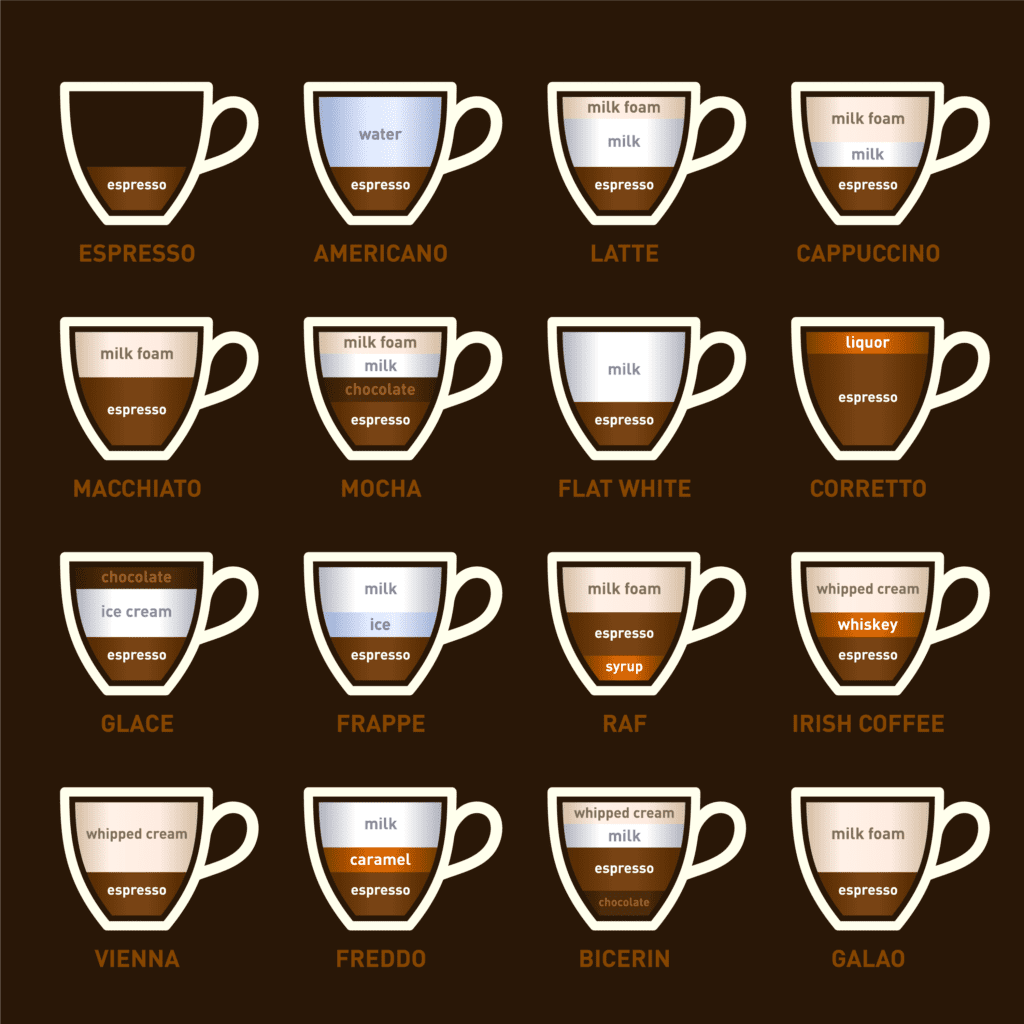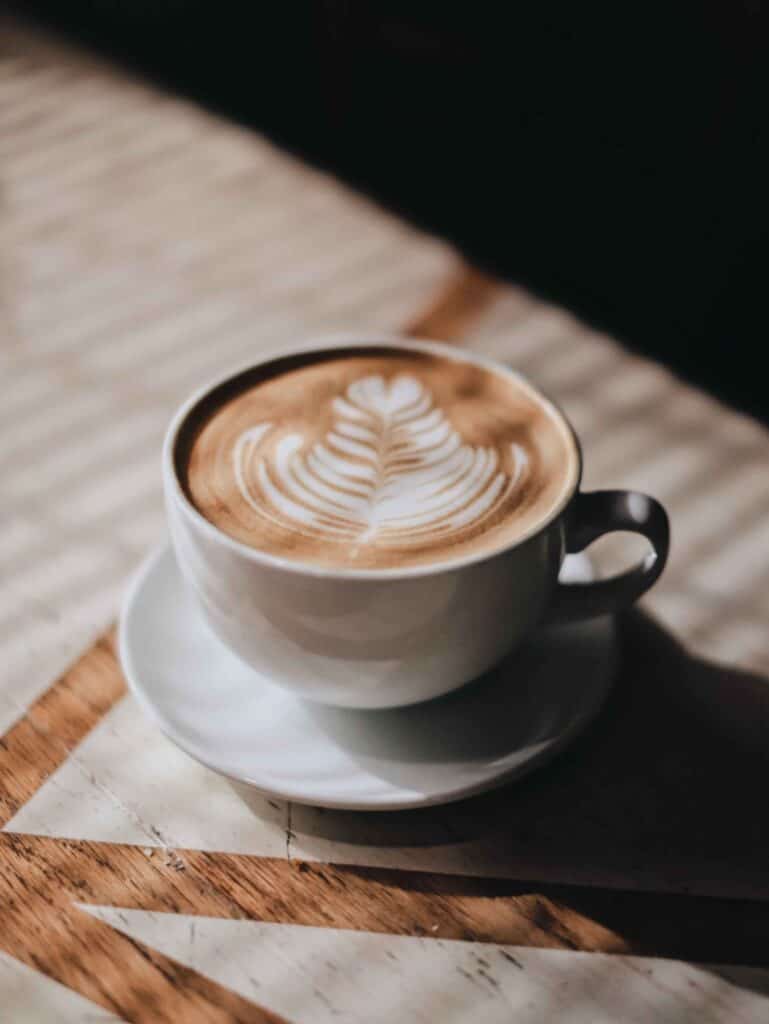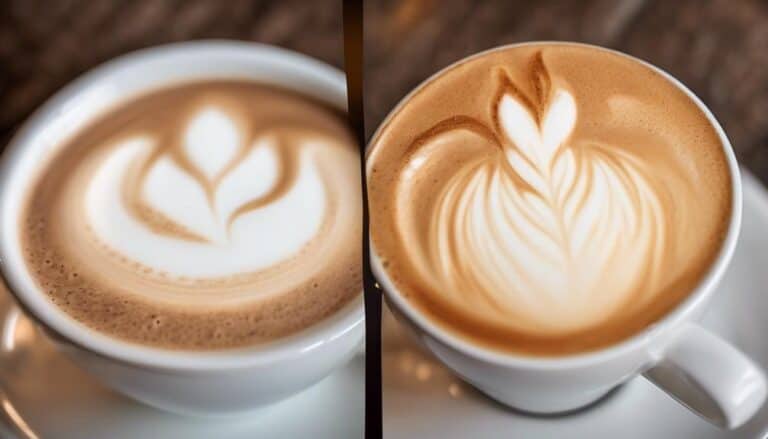Cappuccino vs Latte: Understanding the Differences

Cappuccino and latte are two popular espresso-based drinks that have been enjoyed by coffee lovers for decades. While both drinks have similar ingredients, they are prepared and served differently, resulting in distinct taste and texture profiles. Understanding the differences between cappuccino and latte is crucial to choosing the right drink for your taste preferences.
Cappuccino is an Italian coffee drink that consists of equal parts of espresso, steamed milk, and milk foam. The drink is typically served in a small ceramic cup and is known for its strong espresso flavor and creamy texture. On the other hand, latte is a milder coffee drink that is made by adding steamed milk to espresso. The drink has a higher milk-to-espresso ratio than cappuccino, resulting in a lighter taste and texture.
Whether you prefer the bold taste of cappuccino or the creamy texture of latte, understanding the differences between the two drinks is essential to making an informed decision. In the following sections, we will explore the differences between cappuccino and latte in more detail, including the ingredients, preparation methods, and serving sizes.
Understanding Cappuccino and Latte
Cappuccino and latte are two of the most popular espresso-based beverages in the world. Both drinks are of Italian origin and are made with espresso and milk. However, the differences between the two are created through one important function: barista craft.
Cappuccino
A cappuccino is a classic Italian espresso drink that is distinctly layered. It starts with a bottom layer of one or two shots of espresso (typically two in the United States). The espresso is then topped with steamed milk and a layer of milk foam. The layer of foam is usually thicker than that of a latte, and it is often dusted with cocoa powder or cinnamon.
Cappuccinos are typically served in smaller cups than lattes and are known for their strong coffee flavor. They are often enjoyed in the morning or after dinner, and they are a popular choice for those who prefer a bold, rich espresso taste.
Latte
A latte, on the other hand, is an espresso-based drink that is made by mixing espresso with steamed milk. Unlike a cappuccino, the milk and espresso are mixed together, creating a smooth and creamy texture. Lattes are typically served in larger cups than cappuccinos and are known for their mild coffee flavor.
Lattes can be customized with a variety of flavors, such as vanilla, caramel, or hazelnut, and are often enjoyed as a sweet and creamy treat. They are a popular choice for those who prefer a milder coffee taste or who enjoy adding syrups and flavors to their drinks.
Latte vs Cappuccino
The main difference between a latte and a cappuccino is the ratio of espresso to milk. A latte has more milk than espresso, whereas a cappuccino has more espresso than milk. Additionally, cappuccinos are typically served in smaller cups and have a thicker layer of foam than lattes.
In summary, cappuccinos and lattes are both delicious espresso-based drinks that are enjoyed around the world. While they may seem similar, the differences in their ratios of espresso to milk and the way they are prepared create unique and distinct flavor profiles.
Ingredients and Preparation
Cappuccino Ingredients and Preparation
Cappuccino is made up of espresso, steamed milk, and milk foam. The ratio of espresso to steamed milk to milk foam is approximately 1:1:1. The first step in making a cappuccino is to pull a shot of espresso. A shot of espresso is a 1-ounce shot of coffee that is extracted under high pressure. The espresso shot is then poured into a cup, and steamed milk is added to the espresso in equal parts. Finally, milk foam is added to the top of the drink to create a layer of froth. The milk foam in a cappuccino is thicker and more substantial than that in a latte.
Latte Ingredients and Preparation
Latte is made up of espresso, steamed milk, and a small amount of milk foam. The ratio of espresso to steamed milk is approximately 1:3. To make a latte, a shot of espresso is pulled and poured into a cup. Steamed milk is then added to the espresso in a 3:1 ratio. Finally, a small amount of milk foam is added to the top of the drink. The milk foam in a latte is thinner and less substantial than that in a cappuccino.
When it comes to the type of milk used, whole milk is typically used for both cappuccinos and lattes. However, some coffee shops may offer alternative milk options such as almond milk or soy milk. Additionally, some coffee shops may offer flavored syrups to add to the drink for added sweetness.
The barista plays a crucial role in the preparation of both drinks. They must ensure that the espresso shot is pulled correctly, the milk is steamed to the right temperature, and the milk foam is added to the drink in the right amount. The milk foam can also be used to create latte art, which is a popular trend in coffee shops today.
Overall, both cappuccinos and lattes are made up of similar ingredients, but the ratios and preparation methods differ. The different ratios of espresso to steamed milk to milk foam create different layers and textures in the drink, which affects the overall coffee flavor.
Taste and Texture
When it comes to taste and texture, cappuccino and latte have some differences that are worth exploring. In this section, we will discuss the taste and texture of both drinks.
Cappuccino Taste and Texture
Cappuccino is known for its rich and creamy texture. The drink is made with equal parts espresso, steamed milk, and foam. The foam layer on top of the cappuccino is thicker than that of a latte, which gives it a stronger coffee flavor. The espresso in a cappuccino is also stronger than that of a latte, which contributes to its bolder taste. Overall, cappuccino has a more intense flavor and a thicker, creamier texture than a latte.
Latte Taste and Texture
Latte, on the other hand, has a milder taste and a smoother texture. The drink is made with more steamed milk than a cappuccino, which gives it a creamier texture. The layer of foam on top of a latte is thinner than that of a cappuccino, which contributes to its subtler taste. The espresso in a latte is also milder than that of a cappuccino, which makes it a good option for those who prefer a less intense coffee flavor. Overall, latte has a smoother, creamier texture and a milder, more subtle taste.
It’s worth noting that the taste and texture of both drinks can vary depending on the ratio of ingredients used. Some people may prefer a stronger coffee flavor, while others may prefer a sweeter taste. Additionally, the type of milk used can also affect the taste and texture of the drink. For example, using almond milk instead of cow’s milk can give the drink a nuttier flavor and a thinner texture.
In summary, cappuccino has a richer, creamier texture and a stronger, more intense coffee flavor than a latte. Latte, on the other hand, has a smoother, creamier texture and a milder, more subtle taste. The choice between cappuccino and latte ultimately comes down to personal preference and taste.
Variations and Customizations
When it comes to coffee, the possibilities for variations and customizations are endless. Both cappuccinos and lattes can be made in a variety of ways, with different flavors and ingredients added to suit individual tastes. Here are some of the most popular variations and customizations for cappuccinos and lattes.
Cappuccino Variations
Dry Cappuccino
A dry cappuccino is made with less steamed milk and more foam than a traditional cappuccino. This results in a drier texture and stronger coffee flavor. It’s a great option for those who prefer a stronger coffee taste.
Flavored Cappuccino
Cappuccinos can be flavored with a variety of syrups, such as vanilla, caramel, or hazelnut. These syrups are added to the espresso shot before the milk is steamed, resulting in a sweet and flavorful drink.
Cinnamon Cappuccino
For a warm and spicy twist on a traditional cappuccino, cinnamon can be sprinkled on top of the foam. This adds a cozy, comforting flavor that is perfect for fall and winter.

Latte Variations
Vanilla Latte
A vanilla latte is made by adding vanilla syrup to the espresso shot before the milk is steamed. The result is a sweet and creamy drink that is perfect for those with a sweet tooth.
Cocoa Powder Latte
For a chocolatey twist on a latte, cocoa powder can be sprinkled on top of the foam. This adds a rich and indulgent flavor to the drink.
Peppermint Latte
A peppermint latte is a festive twist on a classic latte. Peppermint syrup is added to the espresso shot before the milk is steamed, resulting in a minty and refreshing drink that is perfect for the holiday season.
Other Variations
Latte Macchiato
A latte macchiato is a layered drink made with steamed milk, espresso, and a small amount of foam. The milk is poured into the glass first, followed by the espresso shot, and then topped with foam. This results in a beautiful layered effect that is both visually appealing and delicious.
Cortado
A cortado is a Spanish drink made with equal parts espresso and steamed milk. It’s a great option for those who prefer a stronger coffee taste, but still want a bit of milk to balance it out.
Flat White
A flat white is a popular Australian drink that is similar to a latte, but with a higher espresso to milk ratio. This results in a stronger coffee taste and a velvety texture.
Starbucks Variations
At Starbucks, cappuccinos and lattes can be customized with a variety of syrups and flavors. Some popular options include caramel, hazelnut, and pumpkin spice. Additionally, Starbucks offers seasonal drinks such as the Chestnut Praline Latte and the Peppermint Mocha, which are only available for a limited time each year.
In conclusion, both cappuccinos and lattes offer a wide range of variations and customizations to suit individual tastes. From flavored syrups to sprinkled cinnamon, there are endless possibilities for creating the perfect cup of coffee.
Nutritional Aspects
When it comes to coffee drinks, nutritional content can vary greatly depending on the type of milk and any added sweeteners. In this section, we will compare the nutritional content of cappuccinos and lattes.
Cappuccino Nutritional Content
A typical cappuccino is made with equal parts espresso, steamed milk, and milk foam. A 12-ounce cappuccino made with whole milk contains approximately 130 calories, 6 grams of fat, and 8 grams of protein. However, the calorie and fat content can vary depending on the type of milk used. For example, a cappuccino made with skim milk will have fewer calories and less fat.
If you prefer flavored cappuccinos, be aware that adding syrups or sweeteners can significantly increase the calorie and sugar content. For example, a hazelnut cappuccino made with whole milk and syrup can contain around 250 calories and 30 grams of sugar.
Latte Nutritional Content
A latte is made with espresso, steamed milk, and a small amount of milk foam. A 12-ounce latte made with whole milk contains approximately 210 calories, 9 grams of fat, and 12 grams of protein. Again, the calorie and fat content can vary depending on the type of milk used.
If you prefer a sweeter latte, be aware that flavored syrups or sweeteners can significantly increase the calorie and sugar content. For example, a mocha latte made with whole milk and chocolate syrup can contain around 360 calories and 35 grams of sugar.

Conclusion
When it comes to choosing between a cappuccino and a latte, the nutritional content is fairly similar. However, if you are looking for a healthier option, choose a cappuccino made with skim milk or a latte made with almond milk or oat milk. Additionally, be mindful of any added sweeteners, as they can significantly increase the calorie and sugar content of your drink.
Popularity and Availability
Cappuccino and latte are two of the most popular coffee drinks in coffee shops and cafes around the world. They are both widely available in most coffee shops, including Starbucks, and are often featured on the menu as classic espresso drinks.
While cappuccino is more popular in Europe, latte has gained popularity in the United States and is often the go-to choice for those who prefer a milder coffee flavor. Both drinks can be served hot or cold, with iced versions becoming increasingly popular in recent years.
In addition to traditional cappuccino and latte, many coffee shops also offer variations of these drinks, such as flavored lattes and cold brew cappuccinos. These variations often feature unique flavor combinations and are a great way to try something new.
Overall, cappuccino and latte are widely available and popular coffee drinks that can be enjoyed in a variety of ways. Whether you prefer a classic cappuccino or a flavored latte, you can find these drinks on the menu at most coffee shops.
Frequently Asked Questions
What is the difference between a cappuccino and a latte?
The main difference between a cappuccino and a latte is the ratio of espresso, steamed milk, and foam. A cappuccino has equal parts of espresso, steamed milk, and foam, while a latte has more steamed milk and less foam. Additionally, a cappuccino is served in a smaller cup than a latte.
Which is sweeter, a cappuccino or a latte?
Neither cappuccino nor latte is inherently sweeter than the other. However, some coffee shops may add sweeteners or syrups to one or both drinks. If you prefer a sweeter taste, you can ask your barista to add a sweetener or syrup to your drink.
Is a latte more caffeinated than a cappuccino?
No, a latte is not more caffeinated than a cappuccino. Both drinks contain the same amount of espresso shots, which is typically one or two shots. However, a latte has more milk and less foam than a cappuccino, which may affect the perceived strength of the drink.
How is a flat white different from a latte?
A flat white is similar to a latte but has less milk and more espresso. A flat white typically has one or two shots of espresso and a thin layer of microfoam on top. In contrast, a latte has more milk and less espresso than a flat white.
What is in a latte?
A latte typically contains one or two shots of espresso, steamed milk, and a small amount of foam. The milk used in a latte can be whole milk, skim milk, or any other type of milk. Some coffee shops may also add flavorings or syrups to a latte.
How does a cappuccino differ from an espresso?
A cappuccino is made with espresso, steamed milk, and foam, while an espresso is just a shot of concentrated coffee. A cappuccino is a milkier and creamier drink than an espresso, which has a stronger and more bitter taste. Additionally, a cappuccino is usually served in a smaller cup than an espresso.






One Comment